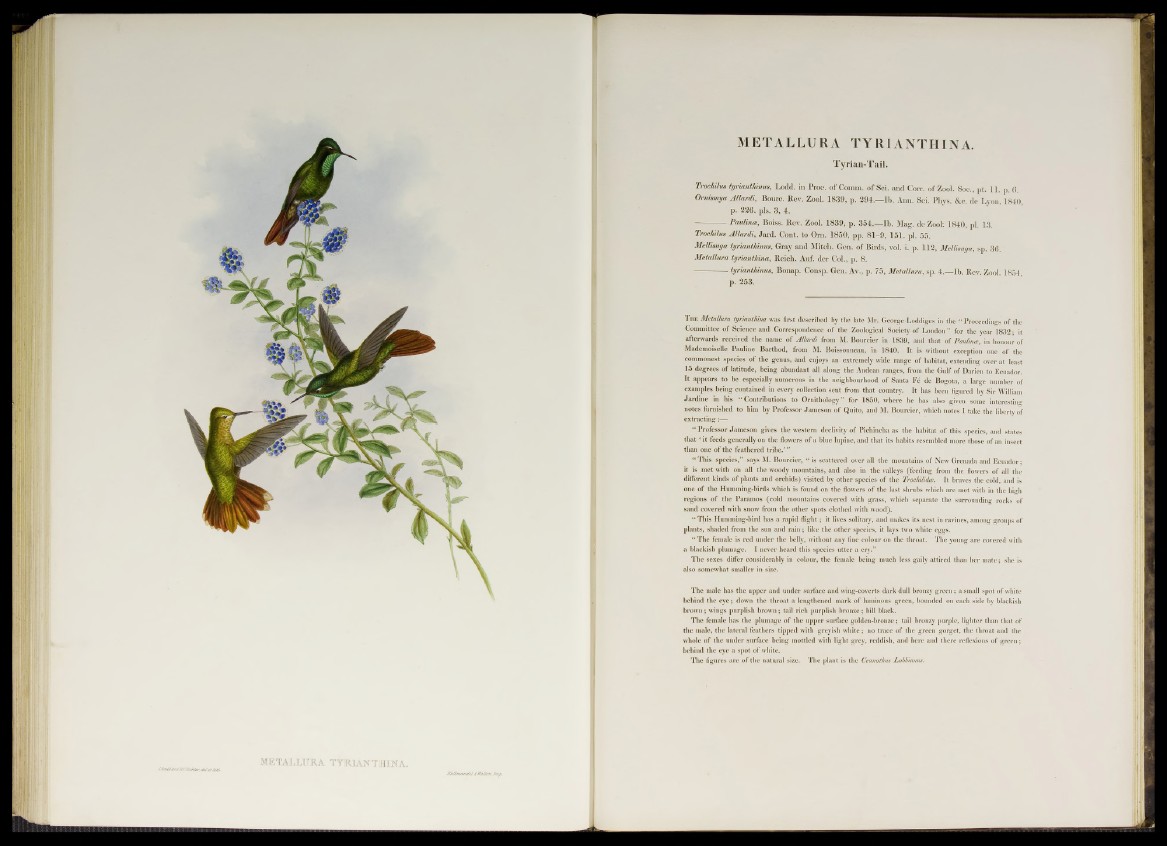
MMruuuM it llii/foii, fori
METALLURA TYRIANTHINA.
Tyrian-Tail.
Trochilus tyrianthinus, Lodd. in Proc. o f Comm, of Sci. and Corr. o f Zool. Soc., pt. 11. p. 6.
Ornismya Allardi, Bourc. Rev. Zool. 1839, p. 294.— Ib. Ann. Sci. Phys. &c. de Lyon, 1840,
p. 226. pis. 3, 4.
— Paulina, Boiss. Rev. Zool. 1839, p. 354.— Ib. Mag. de Zool: 1840, pi. 13.
Trochilus Allardi, Jard. Cont. to Orn. 1850, pp. 8 1 -9 , 151. pi. 55.
Mellusuga tyrianthinus, Gray and Mitch. Gen. o f Birds, vol. i. p. 112, Mellisuga, sp. 36.
Metallura tyrianihina, Reich. Auf. der Col., p. 8.
— tyrianthinus, Bonap. Consp. Gen. Av., p. 75, Metallura, sp. 4.—Ib. Rev. Zool. 1854,
p. 253.
T he Metallura tyrianthina was first described by the late Mr. George-Loddiges in the “ Proceedings of the
Committee of Science and Correspondence of the Zoological Society of London ” for the year 1832 • it
afterwards received the name of Allardi from M. Bourcier in 1839, and that of Paulina, in honour of
Mademoiselle Pauline Barthod, from M. Boissonneau, in 1840. It is without exception one of the
commonest species of the genus, and enjoys an extremely wide range of habitat, extending over at least
15 degrees of latitude, being abundant all along the Andean ranges, from the Gulf of Darien to Ecuador.
It appears to be especially numerous in the neighbourhood of Santa Fe de Bogota, a large number of
examples being contained in every collection sent from that country. It has been figured by Sir William
Jardine in his “ Contributions to Ornithology” for 1850, where he has also given some interesting
notes furnished to him by Professor Jameson of Quito, and M. Bourcier, which notes I take the liberty of
extracting:—
“ Professor Jameson gives the western declivity of Pichincha as the habitat of this species, and states
that ‘ it feeds generally on the flowers of a blue lupine, and that its habits resembled more those of an insect
than one of the feathered tribe.’ ”
“ This species,” says M. Bourcier, “ is scattered over all the mountains of New Grenada and Ecuador;
it is met with on all the woody mountains, and also in the valleys (feeding from the flowers of all the
different kinds of plants and orchids) visited by other species of the Trochilidce. It braves the cold, and is
one of the Humming-birds which is found on the flowers of the last shrubs which are met with in the hHi
regions of the Paramos (cold mountains covered with grass, which separate the surrounding rocks of
sand covered with snow from the other spots clothed with wood).
“ This Humming-bird has a rapid flight; it lives solitary, and makes its nest in ravines, among groups of
plants, shaded from the sun and rain; like the other species, it lays two white eggs.
“ The female is red under the belly, without any fine colour on the throat. The young are covered with
a blackish plumage. I never heard this species utter a cry.”
The sexes differ considerably in colour, the female being much less gaily attired than her mate; she is
also somewhat smaller in size.
The male has the upper and under surface and wing-coverts dark dull bronzy green; a small spot of white
behind the eye; down the throat a lengthened mark of luminous green, bounded on each side by blackish
brown ; wings purplish brown; tail rich purplish bronze; bill black.
The female has the plumage of the upper surface golden-bronze; tail bronzy purple, lighter than that of
the male, the lateral feathers tipped with greyish white; no trace of the green gorget, the throat and the
whole of the under surface being mottled with light grey, reddish, and here and there reflexions of green;
behind the eye a spot of white.
The figures are of the natural size. The plant is the Ceanothus Lobbianus.